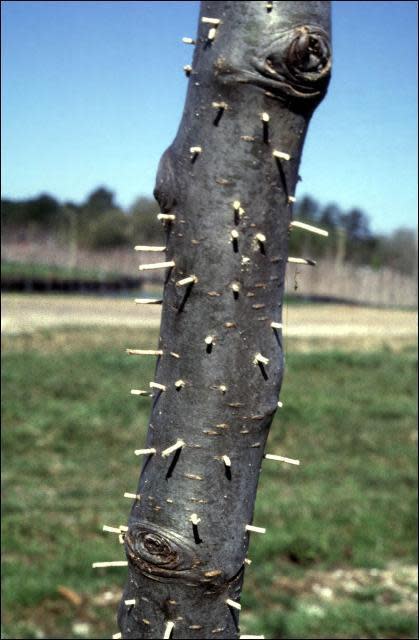Campbell Vaughn: Know the signs of Asian Ambrosia beetles and chinch bugs

With so many little things going on in the landscape this time of year, I thought I would spend a little time on a few that we have been hearing around the office lately.
Zoysia grass has been late to green up this year. The cool spring temperatures and possibly some fall large patch fungus damage has been prevalent. Also seeing some melting out fungus. My advice is to rake as much dead leaf matter out as possible, water deep, fertilize lightly and give it a little time. I think with us warming up some, it is finally going to begin to look like the beautiful grass it is known to be in the next couple of weeks.
We have had some sighting of the dreaded Asian Ambrosia beetle. These small beetles emerge in the spring and the females find a nice new crape myrtle or Japanese maple you spent your hard-earned money on and bore a hole in it to lay eggs.
The holes they leave doesn’t cause the harm, but the ambrosia fungus they bring with them clogs the plants vascular system. Once infested, the plant is doomed.

A definite sign of the Asian Ambrosia beetle is these 1-2 inch looking toothpicks made of sawdust from the boring that will be protruding out of the trunk and limbs of the plant. The plant will droop and lose its leaves and die within a matter of a couple of weeks. Since these “toothpicks” are made of sawdust, heavy winds, rain or an irrigation sprinkler will knock them off, so sometimes you might miss this sure sign of the AAB.
When infested, remove the entire plant and get if off your property ASAP. I preventively treated some of my new plantings in my yard with bifenthrin when I spotted some signs a few weeks ago in the neighbor’s yard.
Chinch bugs are due. They love to feast on hot, dry and sunny areas of St. Augustine lawns. These little guys will come in mass and eat the roots of your beautiful lawn and make you wish you never met them. Damage can be mild to completely destroying a lawn.
Campbell Vaughn: Home landscapes finally comes together
If you are seeing some rapid dying in an area of your St. Augustine grass (sometimes zoysia too), dig up an area about 10 inches squared of sod and submerge it in a 5-gallon bucket half full of water. The little black bugs will rise to the top and you will know you have them. They are excellent swimmers.
I will also get down on my hands and knees (with my reading glasses) and pick thru the grass to look for them as well. A trained eye for spotting them keeps me from having to haul a bucket of water and a shovel around.
Chinch bugs are real common near curbs and sidewalks in the hottest part of the yard. The concrete radiates heat and seems to attract more of them. If you have had them in the past, you will most likely have them in the present. You can treat them preventively or post infestation with the active ingredient bifenthrin or carbaryl.
If you are seeing the tips of your dogwoods, mop head hydrangea and crape myrtles covered in a white cloudy substance, you have powdery mildew. This fungus will keep your plants leaves from forming fully and photosynthesize properly. On crape myrtles, they will cover the buds of the flowers limiting blooming. I like using the systemic fungicide Immunox for treatment. It is readily available around town. If you have Daconil in the garage, it also works well on powdery mildew.
This article originally appeared on Augusta Chronicle: Asian ambrosia beetles and chinch bugs are coming

